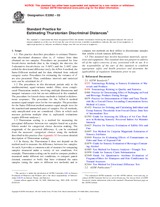Wir benötigen Ihre Einwilligung zur Verwendung der einzelnen Daten, damit Sie unter anderem Informationen zu Ihren Interessen einsehen können. Klicken Sie auf "OK", um Ihre Zustimmung zu erteilen.
ASTM E2262-03
Standard Practice for Estimating Thurstonian Discriminal Distances
Automatische name übersetzung:
Standard Praxis für die Schätzung Thurstonian discriminal Entfernungen
NORM herausgegeben am 10.7.2003
Informationen über die Norm:
Bezeichnung normen: ASTM E2262-03
Anmerkung: UNGÜLTIG
Ausgabedatum normen: 10.7.2003
SKU: NS-44838
Zahl der Seiten: 47
Gewicht ca.: 141 g (0.31 Pfund)
Land: Amerikanische technische Norm
Kategorie: Technische Normen ASTM
Die Annotation des Normtextes ASTM E2262-03 :
Keywords:
distances, discriminal, Thurstonian, ICS Number Code 67.240 (Sensory analysis)
Ergänzende Informationen
| 1. Scope | ||||||||||||||||||||||||||||||||
|
1.1 This practice describes procedures to estimate Thurstonian discriminal distances (that is, d' values) from data obtained on two samples. Procedures are presented for four forced-choice methods (that is, the triangle, the duo-trio, the 3-alternative-forced-choice (or 3-AFC) and the 2-AFC (also called the directional difference test)), the A/Not-A method, the Same-Different method and for data obtained from ordered category scales. Procedures for estimating the variance of d' are also presented. Thus, confidence intervals and statistical tests can be calculated for d'. 1.2 The procedures in this document pertain only to the unidimensional, equal-variance model. Other, more complicated Thurstonian models, involving multiple dimensions and unequal variances exist but are not addressed in this standard. The procedure for forced-choice methods is limited to dichotomous responses. The procedure for the A/Not-A method assumes equal sample sizes for the two samples. The procedure for the Same-Different method assumes equal sample sizes for the matched and unmatched pairs of samples. For all methods, only unreplicated tests are considered. (Tests in which each assessor performs multiple (that is, replicated) evaluations require different analyses.) 1.3 Thurstonian scaling is a method for measuring the perceptual difference between two samples based on a probabilistic model for categorical choice decision making. The magnitude of the perceived difference, δ, can be estimated from the assessors' categorical choices using the methods described in this practice (See Appendix X3 for a more detailed description of Thurstonian scaling). 1.4 In theory, the Thurstonian does not depend on the method used to measure the difference between two samples. As such, δ provides a common scale of measure for comparing samples measured under a variety of test conditions. For example, Thurstonian scaling can be used to compare products measured under different test conditions, to compare panels (trained, consumer or both) that have evaluated the same samples (using the same or different test methods) and to compare test methods on their ability to discriminate samples that exhibit a fixed sensory difference. 1.5 This standard may involve hazardous materials, operations and equipment. This standard does not purport to address all of the safety concerns, if any, associated with its use. It is the responsibility of the user of this standard to establish appropriate safety and health practices and determine the applicability of regulatory limitations prior to use. |
||||||||||||||||||||||||||||||||
| 2. Referenced Documents | ||||||||||||||||||||||||||||||||
|
Empfehlungen:
Aktualisierung der technischen Normen
Wollen Sie sich sicher sein, dass Sie nur die gültigen technischen Normen verwenden?
Wir bieten Ihnen eine Lösung, die Ihnen eine Monatsübersicht über die Aktualität der von Ihnen angewandten Normen sicher stellt.
Brauchen Sie mehr Informationen? Sehen Sie sich diese Seite an.




 Cookies
Cookies
